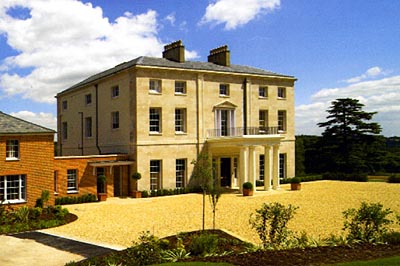 |
 |
|||
|
|
The St. John family of Lydiard Tregoze in Wiltshire had been the owners of Purley Park, the manor house of Purley Magna, since 1514 and it was a popular secondary home. It was probably Henry St. John, 1st Viscount Bolingbroke who replaced the old timber-framed Tudor building, next to the parish church, with a Georgian building around 1743. However, in 1789, the 3rd Viscount Bolingbroke sold the manor to Robert Mackreth, owner of White's Club in Piccadilly, to settle a gambling debt. Mackreth sold it on to his manager, John Martindale, the following year but, by 1793, it had been purchased by Anthony Morris Storer MP. Only the previous year, Storer had inherited his father's fortune, made from sugar plantations in Jamaica. He had big plans for the future of his new estate and, shortly after it came into his possession, he consulted the renowned landscape artist, Humphrey Repton, and commissioned him to re-design the property. Repton was one of England's greatest landscape theorists and designers. He believed that a successful landscape garden required "the powers of the landscape painter and the practical gardener". Repton made a point of considering the house, and its place in the landscape that surrounded it, in his designs. He felt the garden should display the natural beauty of the area, whilst hiding any defects such as evidence of ploughed fields or labour. Repton is famous for producing 'Red Books' for clients. These bound volumes contained recommendations with beautifully detailed watercolours showing the gardens in a 'before and after' state. During his thirty-year career, Repton undertook over 400 commissions, including Tatton Park and Woburn Abbey. The Red Book of Purley Magna, produced by Repton for Anthony Morris Storer in 1793 is still in existence in a private collection and extracts of it are re-produced here by kind permission of its owner: "The house should be more small in appearance, than in reality, it ought therefore to aim at the character of simple elegance; and convenience, than either the affected humility of what is called a ferme ornee, or the splendour and magnificence of a Manorial residence. Its true character will be generally described by calling it a beautiful Casino on the banks of the Thames" "...the view from a house ...should consist of pleasing objects chiefly within the power of the possessor, with distances subordinate to foreground, and thus forming a good landscape, rather than an extensive prospect..." "It unfortunately happens that the present farm house and premises occupy nearly the spot which I consider in every respect the most desirable for the new Casino..." "...there is no more propriety in condemning a situation because once in a number of years it has been overflowed, than in forsaking the vallies of a mountainous region, because in winter they are sometimes liable to have deep snows" "...as the present narrow ditch is not a sufficient impediment to justify the great circuit which is made to arrive at the house, it is the more advisable that its channel be so wide as to furnish a proper excuse for going round to the bridge at F, without any temptation to make a shorter line, especially as the road will be very interesting thro' its whole course by passing within view of the open pleasure ground" "...tho' in reality it consists of a front without any pretensions to architectural taste, or elegance, it is the plain entrance front of a Country Gentleman's seat, which I merely introduced in the drawing to show the effect of change, without presuming to furnish any hint to the Architect..." In 1799, Storer added a codicil to his will, requesting that the distinguished architect, James Wyatt, be appointed "to erect a mansion house and offices at Purley ….. faced with stone similar to that of Francis Sykes at Basildon" at "a cost of £12-15,000". Storer died in July 1799 and the estate passed to his nephew, Anthony Gilbert Storer. He followed the terms of the will and commissioned Wyatt to design the house that we see today. Because a severe flood in 1795 threatened the old manor house next to the Parish Church of St Mary the Virgin, Purley Park mansion was built, between 1800 and 1805, on high ground, with views across the Thames to Reading, an alternative site to the one considered by Humphrey Repton. The estate passed to Major Anthony Morris Storer (1818-1902) and then to his only daughter, Leila, who died in 1918. The estate was broken up and sold by Major Storer's granddaughter, Ivy Leila Downing (Fullerton) Evans in 1920. The house and ground passed through various hands, including Sangers Ltd, the wholesale chemists who evacuated their offices to Purley Park during WW2. In 2003, the house was purchased by developers, T A Fisher of Mortimer, who have converted it into flats. Text reproduced by kind permission of T A Fisher.
|
|||
| © Nash Ford Publishing 2009. All Rights Reserved. | ||||



 Purley Park
Purley Park